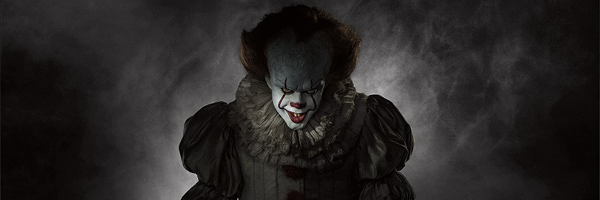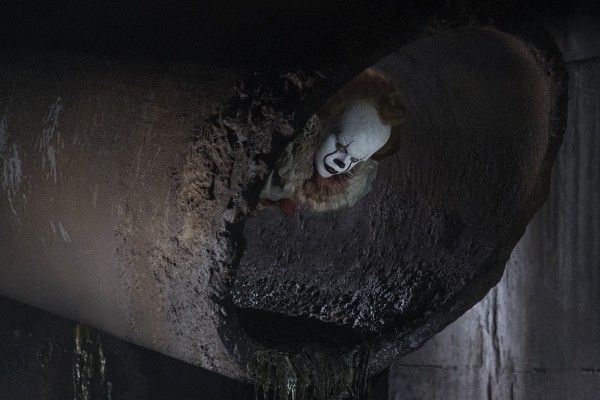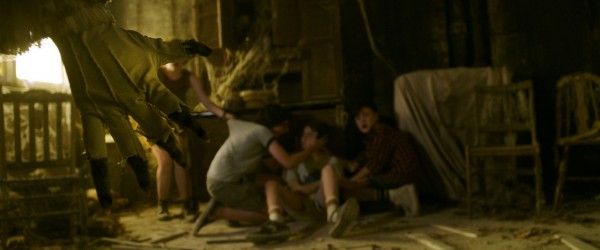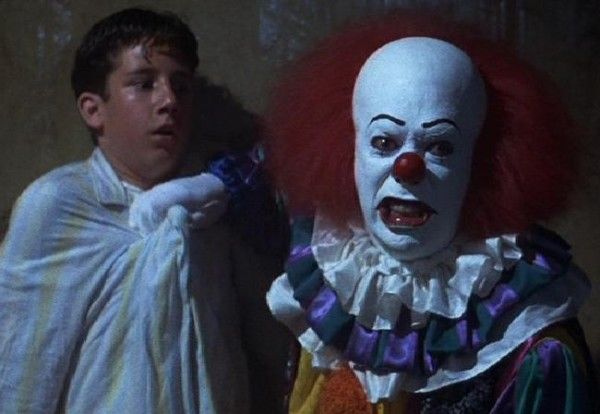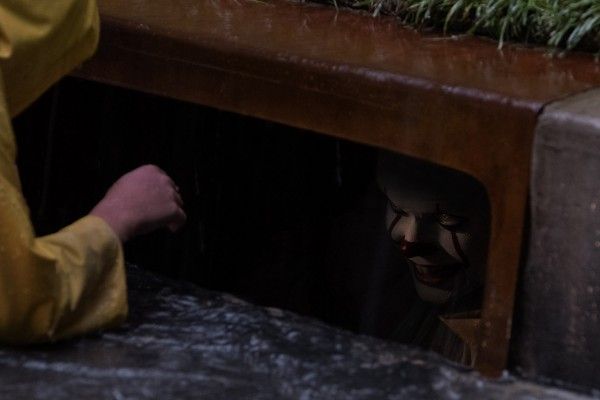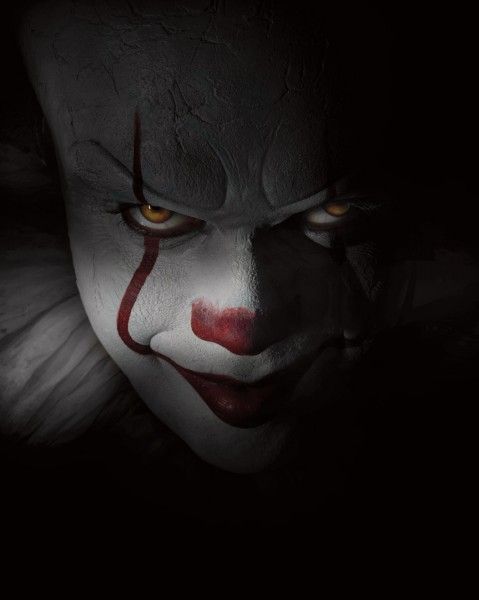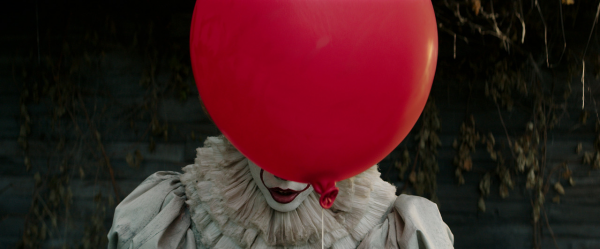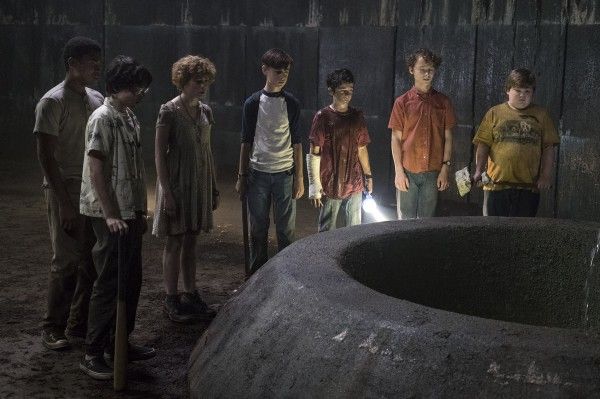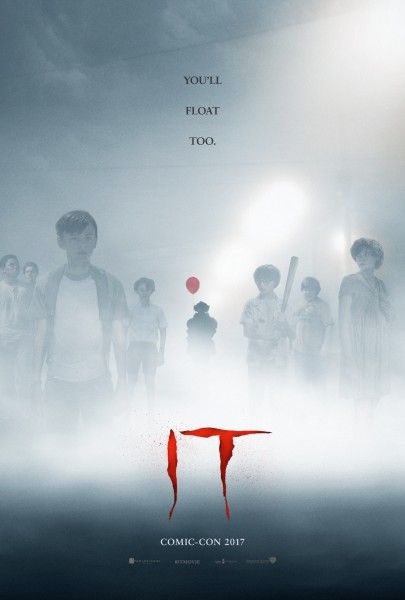There's no shortage of iconic horror characters out there, but few have struck fear into as many hearts as Pennywise, the child-eating, shape-shifting clown created by Stephen King as the force of evil corrupting the small town of Derry, Maine is his horror epic IT. When the book was adapted to miniseries in 1990, Tim Curry transformed the character into a living, breathing force of evil on Bozo's clothes, scaring the wits out of audiences everywhere with a sinister smile and gravelly voice and cementing a generation of kids as clown-phobic.
Now, King's novel is getting the remake treatment once again with Andy Muschietti's IT and this time Bill Skarsgard has stepped up to take on the role of It, aka Pennywise the Dancing Clown. Folks who grew up on Curry's incarnation of the character may be in for a bit of a surprise with IT, which looks back to the source material for a much different interpretation. In the most recent trailer, we finally got to hear Skarsgard's Pennywise talk and where Curry was brash and bullish, Skarsgard is a quieter kind of sinister, snake-like with aspartame artificial sweetness. It's a complete reinvention of the character from top to tail; from script to creature design to performance, and it's genuinely unnerving.
Last year, I had the opportunity to visit the set of IT in Toronto, Canada, where I watched Skarsgard and Muschietti work tirelessly on perfecting a scare and spoke with the cast and creative team (You can read the full IT set visit report here.) Skarsgard was well-occupied inventing some nightmare fuel, so we didn't get to speak to him that day, but the actor was kind enough to jump on the phone with Collider and a couple other outlets a few months later. Skarsgard talked about how he approached the voice of Pennywise, digging into his own fears to become fearsome, working with the cast of kids playing the losers, and much more. Check out what he had to say in the full interview below.
One of the most iconic things about Tim Curry’s Pennywise is his voice. I was wondering if it’s going to be your voice by itself or if they’re going to add anything in or how you formed your voice and what it will sound like?
BILL SKARSGARD: I play around with a lot of different versions of what this thing might sound like. The voice had changed a lot from the first time I had auditioned. I explored different versions of it, what would resonate the most with the audience. It was really when we did the full make-up test and see what the character would actually look like…it’s a very abstract way of preparing for something when you have no idea what he will look like. I didn’t know what the makeup would look like, I had no idea what the prosthetics would look like. Then we started exploring different things and I saw different prototypes of what he might look like and I started working with that. My first test with the prosthetics and makeup was where I saw what the character would actually look like with me in it. That’s something I needed to explore to [discover] what this thing would sound like.
Pennywise is an interesting character because he’s a bit fluid, a projection of elements and fears from the children he torments. What was that like for your performance, to play everything that somebody can be afraid of? I imagine that would be freeing for you.
SKARSGARD: Yeah, absolutely. I mean, I only have my own senses to go on so I wanted to make something that I would be scared of [laughs]. So an important thing for me in terms of preparing and creating the character was thinking “What are the things that I would find really unsettling?” And then explore that. Your own kind of fears and what you find disturbing and amplify that in terms of the performance. Essentially, what you’ll end up seeing in the film is my own deepest fears embodied in this character [laughs].
Obviously, it’s an extremely abstract character because the character is an entity taking the shape of a clown. I had to first figure out what the entity was and what the thing was that is taking the shape of the clown. The second step is to create the clown itself. I didn’t want the clown to be completely separate from the entity, right? I wanted “it” to really shine through Pennywise as opposed to just Pennywise being the clown. So a lot of what the entity is I wanted to be in the background of who Pennywise is at all times. There’s a line in the original book where it goes something like “the clown was its favorite form.” It really enjoyed being the clown. He preferred to take the shape of the clown. Obviously, that opened ways of thinking. Why does he prefer being the clown? But also there is this sense of enjoyment. The entity that is “it” is enjoying being the clown. There were a lot of abstract ways to look at it. I tried to take all of those in consideration when I embodied the character. That was very exciting.
A lot of the time when someone takes on a role played by someone else, they try to avoid watching that original performance. But Tim Curry’s performance has become so iconic. What was your relationship to that original performance and coming up with a new spin?
SKARSGARD: I watched the miniseries going into this. I think I did it during the casting process, before I booked the job. I watched the whole thing. It’s cute [laughs]. It’s very dated, you know? Tim Curry’s performance is understandably iconic still, but the whole thing, to me at least, felt like something that may be worth a remake. Or rather a re-adaptation. By watching it and seeing Pennywise as people know him…because there are two different Pennywises. There’s the Pennywise in the book, so people who have read the book first will probably have their own vision of how Pennywise is. And the people who saw the miniseries first will probably think that as Pennywise. There is, already, two different versions. The one in the book is left up to your imagination because whoever reads it will interpret it differently. So in a sense, there’s an infinite amount of different Pennywises.
I watched the miniseries and really appreciated Tim Curry’s take on it, but now I had to do something completely different. Obviously, that’s not something you study. I wouldn’t see the point in making a film that’s similar to the one that’s already been made, so I didn’t try to think too much about that. I just worked really hard to create my own interpretation of Stephen King’s character.
Just about every scene you have involved kids. So how do you work with child actors when you’re supposed to be terrifying them at all times?
SKARSGARD: The kids were great. They really lucked out with the cast that they got. I’m not going to take any credit away from Andy, who directed it, and he was really pursuing these kids. He’s very good at casting, if I may say so myself [laughs]. But all these kids were amazing little actors. We tried to keep them separate from me because we thought that might be a good idea, working with kids. Let’s keep me, as myself, separate from them. But of course, also the character. So we could have this tension between Pennywise and the kids. The kids had already been shooting for a month before they started doing the scenes with Pennywise.
The first day of shooting, I’m working with this actor, Jack Grazer, who plays Eddie in the film. It’s a very intense physical scene where I’m an evil clown and I’m really going after it, you know? Those scenes can sometimes be pretty intense. I think the scene itself was kind of intense for Jack. It’s physical and it’s kind of a lot. After the first take, I tried to make sure he was okay. And he was really excited. He was like “Yeah, that was great, man! That was amazing! I love what you’re doing with the character!” And he was really excited about it and I was like okay, I’m not actually dealing with young kids here. These are little actors! That was really fun. It was fun working with them. I tried to bring out the best in them as we were shooting. Encourage them. Andy was amazing at encouraging the kids and encouraging them to explore. They would say things, they would come up with ideas. They are very smart and creative people. So that was a lot of fun.
The only difference in the cast was working with Georgie, whose name is Jackson. He was 7 years old. That was different because he was way younger than the other kids. We had to work with him a little differently. Shooting that storm drain scene, he was noticeably affected by the sight of me in the storm drain. I’ll just put it that way [laughs]. But we’re good friends in real life!
Cary Fukunaga was originally attached but he left and Andy Muschietti came on with some new ideas. What was it like working with him as your director and what was your collaborative process like?
SKARSGARD: I love working with Andy. I think he’s amazing. He’s become a very close friend to me through the process of working together. I was never involved with Cary’s film. I never auditioned for it. I was never involved at all with that first attempt. I came in later when Andy was directing it and casting it. There were a lot of amazing actors who read for it. I think there were a lot of amazing versions of Pennywise just in the casting process. I think you could have made ten different versions of this film with ten different actors who would do it just as good as I did.
But Andy responded to something I did with the performance or something I brought to the table. Just by going through that casting process… Obviously, everyone who went in for it had a character. It’s such a full-on character, you have to come up with, even in the casting process, a very particular character who you think is right. He responded to whatever I came up with. So even going into production, this was a guy who responded to something that I thought the character would be like. We had that connection. We both had similar ideas about what we wanted to do with the character. That started in the casting process, but it was very true throughout the whole production. I don’t think we ever really argued about anything about the character. I think we were always on the same note about what we wanted to do. That’s not as common as you’d hope in actor-director relationships. It was a lot of fun and I’m looking forward to working with him many more times in the future.
A lot of us saw you shooting the scene where you were crawling out of the slide projector. Something that I noticed was that your performance was a lot more animalistic than I was expecting. There was yipping and growling. Stuff like that. An actor has to trust his director under any normal circumstance, but here you are, climbing out of a green square, yipping and going nuts. Was that level of trust crucial to letting you try stuff like that?
SKARSGARD: We did everything in so many different ways. I don’t think I could have done it if I didn’t trust what Andy liked. He would say “This is great, I’m really responding to this” and I would just continue to do it, whatever it was. Essentially, it was the most weird, scary and disturbing thing we could come up with. It was important to me that there was something absurd about the character. Something inexplicable. Why is he doing this? Unpredictable absurdity to the character that will catch people off guard. This kind shock factor where you never know what this guy is going to do next. You have no idea what he’ll do or how he’ll do it. There’s no way of predicting his behavior. Obviously, that meant there was a lot of chaotic scenes and weird explosive things that we did. We’d explore it. If I didn’t have that trust in Andy, I don’t think that I’d ever be able to do it. You need to when you do something that out there.
Earlier, you mentioned that you pulled something out of Stephen King’s book that really helped you define the character. How much of the character that we’ll see on the screen did you pull from the original text?
SKARSGARD: I used the book as…I think it’s almost 1,200 pages. What was in the script was not much at all about who this character is. It’s a 120 page script and there’s a point to not having too much Pennywise in it. You need to keep him mysterious. But for me, I had to make Pennywise anything but mysterious because I need to understand him as well as I can. I read the book and I took a lot of notes on anything that described Pennywise in any way or “it” in any way. A lot of great chapters. There’s one chapter in particular where “it,” the entity “it,” is the narrator and you hear his thoughts and what he thinks like. So there was this huge source material to go from. What is this thing? Why is he here? What does he think like? What does he like? What doesn’t he like? I could use all of those things to come up with my own version and my own interpretation of what “it” is and also what Pennywise is. And then using all of that with my own ideas and my own thoughts and conclusions, I could apply them to the more limited version in the script.
At the end of the day, that’s what acting is all about. You almost create this infinite universe for the character that you’re playing and then you’re compromising it into the story that you’re doing. Whatever character you're playing, you kind of explore endlessly more than what’s on the page. You use that exploration to do the performance that’s in the film, but hopefully, people will see all that work and preparation in those little glimpses of scenes and moments. Oh, there’s something there. There’s so much more happening with this character. If people watch the film a couple of times, they’ll see into and understand my Pennywise more and more.

